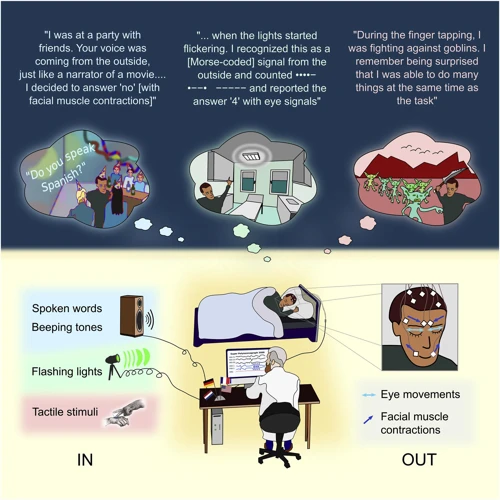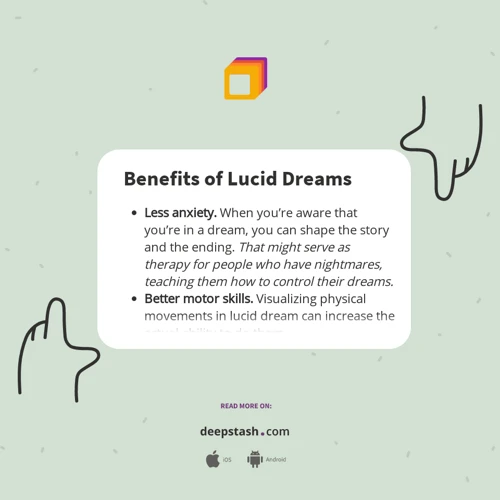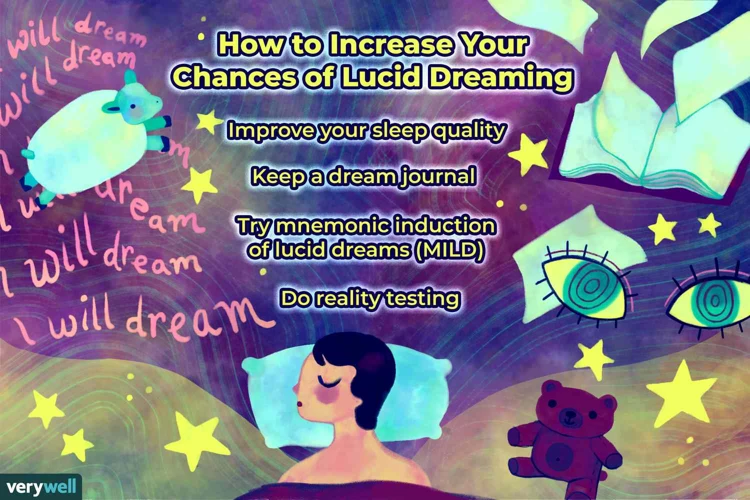Lucid dreaming, a phenomenon where individuals become aware that they are dreaming while still in the midst of their dreams, has long fascinated and perplexed scientists and dreamers alike. What exactly happens in the brain during these conscious dreams? How can one harness the power of their own mind to control and explore these alternate realities? In this article, we delve into the science behind lucid dreaming, exploring the dream cycles, neurological studies, and brain activity associated with this extraordinary experience. Additionally, we will uncover the benefits of lucid dreaming, techniques to achieve it, and tips for enhancing the overall dream experience. So, strap in and get ready to unlock the secrets of your sleeping mind.
The Basics of Lucid Dreaming

Lucid dreaming, a state where individuals become aware that they are dreaming while still asleep, opens up a world of endless possibilities and wonder. In order to understand the basics of lucid dreaming, it is important to first grasp the concept of dreams themselves. Dreams occur during the rapid eye movement (REM) stage of sleep, a phase characterized by heightened brain activity and vivid hallucinations. However, unlike regular dreams where we passively observe the events unfolding, lucid dreams grant us the ability to actively participate and control the dream narrative by utilizing our conscious awareness. Lucid dreamers often report a sense of empowerment and freedom as they navigate through various dream scenarios, effortlessly defying the constraints of reality. While the experience of lucid dreaming varies from person to person, the fundamental aspect remains the same: the realization that one is dreaming while still within the dream. This self-awareness serves as the cornerstone of lucid dreaming, allowing individuals to explore and manipulate their dreamscape in ways they never thought possible. By understanding the basics of lucid dreaming, we can begin to unlock the immense potential of our own minds and embark on incredible journeys within the realm of dreams. (Link: /understanding-lucid-dreaming-basics/)
The Science Behind Lucid Dreaming

Lucid dreaming has captivated researchers and scientists who aim to unravel the mysteries behind this intriguing phenomenon. The science behind lucid dreaming revolves around the understanding of dream cycles, neurological studies, and brain activity that occur during this unique state of consciousness. Dream cycles, particularly the rapid eye movement (REM) stage of sleep, play a crucial role in the occurrence of lucid dreams. Studies have shown that individuals are more likely to experience lucid dreams during REM sleep, when brain activity increases, resembling wakefulness. Neurological studies have revealed that lucid dreaming involves a network of brain areas, including the prefrontal cortex, responsible for self-awareness and decision-making. Researchers have also observed distinct patterns of brain activity during lucid dreaming, with enhanced activity in areas associated with self-reflection and emotion regulation. Understanding the science behind lucid dreaming provides valuable insights into the mechanisms and potential applications of this phenomenon, opening up avenues for further exploration and research. (Link: /exploring-connection-lucid-dreaming-out-of-body-experiences/)
1. Dream Cycles and REM Sleep
Dream cycles and REM sleep play a crucial role in the phenomenon of lucid dreaming. The sleep cycle consists of multiple stages, with REM sleep being the stage most closely associated with vivid dreams. During REM sleep, the brain becomes highly active, comparable to levels seen during wakefulness. It is within this stage that lucid dreams are most likely to occur. Understanding the relationship between dream cycles and REM sleep is vital for those seeking to experience lucid dreaming. Typically, throughout the night, we experience several cycles of REM sleep, each cycle lasting longer as the night progresses. The first REM sleep stage occurs approximately 90 minutes after falling asleep and lasts for a short duration, with each subsequent REM stage becoming increasingly longer. It is during these longer REM stages that the potential for lucid dreaming is heightened. By paying attention to our sleep patterns and aiming to wake up during a REM stage, we can increase the likelihood of having lucid dreams. Techniques such as the Wake-Back-to-Bed (WBTB) method involve setting an alarm to wake up during a REM stage, then utilizing various lucid dreaming techniques to induce and prolong the experience. Understanding the connection between dream cycles, REM sleep, and lucid dreaming is a crucial step towards unlocking the potential of conscious dreaming. (Link: /different-techniques-lucid-dreams/)
2. Neurological Studies on Lucid Dreaming
Neurological studies on lucid dreaming have provided valuable insights into the brain activity and processes that occur during this unique state of consciousness. Research has shown that areas of the brain associated with self-awareness and introspection, such as the prefrontal cortex, exhibit heightened activity during lucid dreaming. This suggests that lucid dreaming involves a form of metacognition, where individuals possess knowledge about their own thoughts and mental processes within the dream environment.
One study conducted by Ursula Voss and her team at the Goethe University in Frankfurt used an electroencephalogram (EEG) to measure brain activity during lucid dreaming. The researchers found that lucid dreaming differs from regular dreaming in terms of electrical brain patterns. While both states share similar characteristics during REM sleep, lucid dreaming exhibits additional gamma oscillations in the EEG readings, indicating heightened cognitive processing and connectivity between different brain regions.
Another study led by Martin Dresler at the Max Planck Institute for Psychiatry utilized functional magnetic resonance imaging (fMRI) to investigate brain activity during lucid dreaming. The results revealed increased activation in the prefrontal cortex, parietal lobes, and other regions associated with attention, working memory, and self-reflection. This heightened brain activity suggests that lucid dreaming may involve a combination of conscious awareness and the ability to exert cognitive control within the dream state.
These neurological studies shed light on the fascinating mechanisms behind lucid dreaming and provide scientific evidence supporting its validity as a distinct phenomenon. By examining the brain activity and regions involved, researchers are beginning to unravel the intricacies of lucid dreaming and its potential implications for understanding consciousness and the nature of reality. As further research continues to unravel the mysteries of lucid dreaming, we gain a deeper understanding of this extraordinary state of consciousness and its significance in the realm of neuroscience and dream exploration.
3. Brain Activity during Lucid Dreaming
During lucid dreaming, the brain undergoes fascinating and distinct patterns of activity that distinguish it from regular dreaming or wakefulness. Research has shown that certain regions of the brain display heightened activation during lucid dreaming. One of the key areas involved is the prefrontal cortex, responsible for decision-making, self-awareness, and logical thinking. In lucid dreamers, the prefrontal cortex shows increased activity, indicating a higher level of conscious thought and control within the dream state. Additionally, the parietal cortex, responsible for spatial awareness, sensory integration, and self-perception, also exhibits enhanced activation during lucid dreaming. This heightened activation may explain the vivid sensory experiences and the sense of embodiment that lucid dreamers often report. The amygdala, known for its role in processing emotions, has also been found to have increased activity during lucid dreaming, potentially contributing to the intense emotions experienced within dreams. Studies have suggested that the combination of these brain regions working together creates a unique cognitive state that allows individuals to recognize and manipulate their dreams. However, further research is needed to fully understand the intricacies of brain activity during lucid dreaming and its role in facilitating conscious awareness within the dreaming realm.
Benefits of Lucid Dreaming

Lucid dreaming not only provides a fascinating experience but also offers a multitude of benefits that can positively impact our waking lives. One of the primary advantages of lucid dreaming is the opportunity for personal growth and self-improvement. When we are conscious within our dreams, we can actively engage in practice and rehearsal for real-life scenarios. Whether it’s overcoming fears, improving skills, or enhancing creativity, lucid dreaming provides a safe and controlled environment for experimentation and development. Another significant benefit is the potential for psychological healing and therapy. During lucid dreams, individuals can confront and process unresolved emotions, traumas, or anxieties, helping to alleviate psychological distress and promote healing. Additionally, lucid dreaming can enhance problem-solving abilities, as the dreamer can actively seek solutions and insights from their subconscious mind. Lucid dreams can also serve as a source of inspiration, creativity, and artistic expression, allowing individuals to tap into their imaginative and innovative capacities. Lucid dreaming can even offer a sense of adventure and excitement, granting the dreamer the ability to explore new and fantastical worlds. With all these benefits, it is clear that lucid dreaming is not just a whimsical experience but a potentially transformative tool for personal growth and self-discovery. (No anchor relevant to include a hyperlink)
Techniques to Achieve Lucid Dreaming

Achieving lucid dreaming requires various techniques and practices that can help individuals enhance their chances of becoming aware within their dreams. Here are some effective methods to aid in the attainment of lucid dreaming:
- Reality Checks: Conducting reality checks throughout the day can train the mind to question whether one is in a dream or reality. Examples include examining your surroundings, trying to push your finger through your palm, or checking the time multiple times.
- Mnemonic Induction of Lucid Dreams (MILD): This technique involves setting an intention before falling asleep, repeatedly reminding oneself of the desire to have a lucid dream. Visualizing the dream scenario and affirming one’s ability to become aware within the dream can significantly increase the likelihood of lucidity.
- Wake-Back-to-Bed (WBTB) method: This technique involves waking up after a few hours of sleep, staying awake for a short period of time, and then returning to sleep with the intention of having a lucid dream. This method takes advantage of the natural REM rebound effect, increasing the opportunities for lucidity.
- Sleep Hygiene Practices: Creating an optimal sleep environment by practicing good sleep hygiene can indirectly support lucid dreaming. This includes maintaining a consistent sleep schedule, avoiding stimulants before bed, and ensuring a comfortable sleep environment conducive to relaxation and deep sleep.
By employing these techniques, individuals can increase their chances of experiencing the remarkable phenomenon of lucid dreaming and embark on extraordinary adventures within their own subconscious realm.
1. Reality Checks
Reality checks serve as a crucial technique for achieving lucid dreaming. These checks involve questioning the reality of one’s surroundings throughout the day. By incorporating this practice into our daily lives, we increase the likelihood of performing a reality check within a dream. The idea is to develop a habit of questioning whether we are dreaming or awake, so that this habit carries over into our dream state. There are several effective reality checks that can be performed: one can try to push a finger through the palm of the opposite hand, as in dreams, this often results in the finger passing through. Another approach is to examine text or numbers, look away, and then look back to see if they have changed or distorted, as in dreams, text tends to change when read a second time. Additionally, attempting to fly or levitate can be a useful reality check, as these actions are typically only possible in dreams. The key is to perform these reality checks throughout the day with genuine curiosity and open-mindedness. By making reality checks a habit, we are more likely to incorporate them into our dreams, ultimately leading to the realization that we are, in fact, dreaming. (Link: /different-techniques-lucid-dreams/)
2. Mnemonic Induction of Lucid Dreams (MILD)
Mnemonic Induction of Lucid Dreams (MILD) is a popular technique used to induce lucid dreaming. It involves setting intentions and using mnemonic cues to trigger lucidity while dreaming. Here is a step-by-step breakdown of how to practice the MILD technique:
1. Bedtime Routine: Establish a regular sleep schedule and create a relaxing bedtime routine. This helps improve overall sleep quality and increases the likelihood of becoming lucid in dreams.
2. Affirmations: Before falling asleep, repeat a specific phrase or affirmation to yourself. For example, you may say, “Tonight, I will realize I am dreaming.” Repeat this affirmation with conviction and believe that it will happen.
3. Dream Recall: Upon waking up from a dream, try to recall as many details as possible. Write down the dream in a dream journal to enhance dream recall over time. This practice helps train the mind to become more aware of dreams and their content.
4. Visualize: While lying in bed, visualize yourself becoming lucid in a recent dream. Imagine recognizing dream signs, questioning your reality, and realizing that you are dreaming. Visualize this scenario as vividly as possible, engaging all your senses.
5. Mnemonic Cue: As you visualize becoming lucid, choose a specific cue that will prompt you to recognize you are dreaming. It can be anything that is likely to occur in your dreams, such as seeing a specific person, object, or event. Repeat this cue along with your affirmation before falling asleep.
6. Reality Checks: Throughout the day, perform reality checks to question whether you are dreaming or awake. This habit will transfer into your dreams, increasing the chances of becoming lucid. Common reality checks include looking at your hands, trying to push your finger through your palm, or attempting to read text.
7. Wake-Back-to-Bed: Set an alarm to wake up after approximately 4-6 hours of sleep. Use this time to read about lucid dreaming or engage in activities that promote wakefulness, such as light stretching or meditation. This period of wakefulness increases the chances of having a lucid dream during the subsequent sleep cycle.
Remember, practicing the MILD technique takes time and consistency. It requires a dedicated effort to incorporate these steps into your bedtime routine. With practice and persistence, MILD can be an effective tool for inducing lucid dreams and exploring the wonders of your own consciousness. So, keep affirming, visualizing, and questioning your reality, and you may soon find yourself experiencing the incredible world of lucid dreaming.
3. Wake-Back-to-Bed (WBTB) method
The Wake-Back-to-Bed (WBTB) method is a popular technique employed by lucid dreamers to increase their chances of experiencing a lucid dream. It involves setting an alarm to wake up in the middle of the night, typically during the REM sleep stage when dreams are most likely to occur. Once awake, individuals stay awake for a short period of time, ranging from 20 minutes to an hour, engaging in activities that promote alertness and mental activity. This could include reading about lucid dreaming, practicing reality checks, or journaling about dreams. After this wakeful period, individuals return to bed with the intention of attempting a lucid dream. The rationale behind the WBTB method is that the interruption in sleep increases the likelihood of entering directly into a REM period, which is when lucid dreams are most likely to happen. By interrupting the sleep cycle and then re-entering it intentionally, individuals are able to capitalize on the naturally occurring REM stage and increase their chances of lucidity. It is important to note that the success of the WBTB method may vary from person to person, and individuals may need to experiment with different wake-up times and activities to find what works best for them. The WBTB method can be an effective technique for inducing lucid dreams and is a valuable addition to the lucid dreaming toolkit.
4. Sleep Hygiene Practices
Sleep hygiene practices play a crucial role in enhancing the potential for lucid dreaming. Creating a conducive environment for quality sleep can significantly improve one’s chances of achieving lucidity during dreams. One key aspect of sleep hygiene is maintaining a consistent sleep schedule. Going to bed and waking up at the same time every day helps regulate the body’s internal clock, making it easier to enter the REM sleep phase where dreams, including lucid dreams, occur. Additionally, practicing relaxation techniques such as meditation or deep breathing before sleep can help calm the mind and prepare it for the dream state. It is also important to create a comfortable sleeping environment by keeping the bedroom dark, quiet, and at a cool temperature. Avoiding electronic devices and stimulating activities before bed is essential, as the blue light emitted from screens can interfere with the production of melatonin, a hormone that regulates sleep. Establishing a relaxing bedtime routine, such as reading a book, taking a warm bath, or listening to soothing music, can signal to the brain that it’s time to unwind and enter a restful sleep. By incorporating these sleep hygiene practices into one’s daily routine, individuals can optimize their chances of experiencing lucid dreams and embarking on remarkable dream adventures.
Tips for Enhancing Lucid Dreaming Experience

Enhancing the lucid dreaming experience requires some additional techniques and practices to optimize the frequency and clarity of lucid dreams. One essential tip is to keep a dream journal, where dreamers can jot down their dreams as soon as they wake up. This practice helps improve dream recall and aids in recognizing dream patterns, leading to an increased likelihood of becoming lucid. Another useful tip is to incorporate meditation and mindfulness into daily routines. By cultivating present-moment awareness and developing a focused and calm mind, individuals can enhance their ability to recognize and sustain lucidity within a dream. Additionally, visualization techniques can be employed to imagine and rehearse lucid dreams, creating a mental blueprint for desired dream scenarios. Lastly, for those looking to amplify their lucid dreaming experience, there are certain supplements, such as vitamin B6 and galantamine, that have been shown to potentially increase dream vividness and lucidity. By utilizing these tips and techniques, dreamers can elevate their lucid dreaming experience and embark on truly extraordinary dream adventures.
1. Dream Journaling
Dream journaling, a widely recommended technique for enhancing lucid dreaming, involves keeping a record of your dreams on a regular basis. The process is simple yet powerful. Upon awakening from a dream, take a few moments to jot down as many details as possible in your dream journal. This includes the storyline, characters, emotions, and any distinct features or events that stood out to you. By consistently recording your dreams, you train your mind to become more attentive and aware of the dream world. Over time, patterns and recurring themes may emerge, providing valuable insights into your own dreamscapes. The act of writing down your dreams reinforces the memory and improves dream recall, making it easier to recognize when you are in a dream state. Additionally, keeping a dream journal allows you to reflect on your dreams and identify dream signs or triggers that can act as cues for lucidity. For instance, if you consistently dream of flying or encountering peculiar creatures, these elements can serve as reminders to question your reality and trigger lucidity. So, grab a journal and pen, and immerse yourself in the rich tapestry of your dream world through the practice of dream journaling.
2. Meditation and Mindfulness
Meditation and mindfulness practices can greatly enhance the ability to achieve and explore lucid dreaming. These techniques involve cultivating a state of focused attention and awareness, both during waking hours and before sleep. By incorporating meditation into your daily routine, you train your mind to be more present and observant, which can carry over into your dream state. Here are some ways meditation and mindfulness can aid in lucid dreaming:
- Mindfulness throughout the day: Practicing mindfulness during your waking hours can create a habit of awareness that can extend into your dreams. By being fully engaged in the present moment, you develop the ability to recognize when you are in a dream. This heightened level of self-awareness can trigger lucidity, allowing you to take control of your dream environment.
- Pre-sleep meditation: Engaging in meditation before bedtime can help calm the mind and foster a relaxed state conducive to lucid dreaming. As you meditate, focus on setting an intention to become aware within your dreams. This intention can carry over into your subconscious mind, increasing the likelihood of experiencing lucidity during sleep.
- Dream incubation: Incorporating meditation and mindfulness into the process of dream incubation involves visualizing desired dream scenarios. By vividly imagining yourself becoming lucid in specific dream settings, you can program your mind to recognize those dream elements while you sleep. This practice improves the chances of lucid dreaming and enhances the overall dream experience.
Meditation and mindfulness play a crucial role in the world of lucid dreaming. By training the mind to be more present and aware, these practices can help individuals recognize and take control of their dream states. Integrating mindfulness throughout the day, engaging in pre-sleep meditation, and utilizing dream incubation techniques can significantly enhance the likelihood and quality of lucid dreaming experiences. So, carve out some time in your day for quiet contemplation, and open the doors to a realm where your dreams become your reality.
3. Visualization Techniques
Visualization techniques play a crucial role in enhancing the lucid dreaming experience. By harnessing the power of our imagination and visualization skills, we can create a vibrant and vivid dream world that is both immersive and controllable. One effective technique is to regularly practice visualization exercises during the waking hours. This involves visualizing specific dream scenarios, such as flying through the sky or exploring a mystical landscape. By vividly picturing these experiences in our minds, we strengthen the connection between our waking and dreaming selves. Engaging in daily visualization exercises helps to train our brain to recognize and recreate these imagined scenarios during our dreams, increasing the likelihood of experiencing lucidity. Another powerful technique is to use visual cues or triggers within the dream itself. This involves setting an intention before falling asleep to notice specific dream signs or symbols that will serve as a reminder that we are dreaming. For example, one may visualize seeing a red balloon or an unusual object in their dream, and then make a conscious effort to look for that exact sign while dreaming. This practice helps to solidify the link between the waking and dreaming states, making it easier to recognize the dream and initiate lucidity. Visualization techniques can truly unlock the full potential of lucid dreaming, allowing us to create and explore incredible dreamscapes limited only by our imagination. (No anchor for internal link)
4. Lucid Dreaming Supplements
In the quest to enhance the lucid dreaming experience, many individuals turn to the aid of supplements specifically designed to promote vivid and conscious dreams. These lucid dreaming supplements claim to support mental clarity, dream recall, and overall dream intensity. One popular supplement is galantamine, a plant-derived compound that has been used for centuries in traditional medicine. Galantamine is believed to increase the levels of acetylcholine in the brain, a neurotransmitter closely associated with memory and cognition. By taking galantamine before sleep, individuals have reported more frequent and vivid lucid dreams. Another commonly used supplement is the amino acid, 5-HTP, which is a precursor to serotonin. Serotonin is involved in regulating mood and sleep, and by increasing its levels, 5-HTP may contribute to more vivid and memorable dreams. However, it is important to note that while these supplements may have anecdotal evidence supporting their effectiveness, scientific research on their safety and efficacy is limited. As with any dietary supplement, it is crucial to consult with a healthcare professional before incorporating them into your routine. Additionally, it is important to prioritize a healthy sleep schedule, proper nutrition, and overall well-being as the foundation for achieving high-quality lucid dreams.
Common Myths about Lucid Dreaming

Lucid dreaming has captured the curiosity of many, resulting in a variety of myths and misconceptions surrounding this fascinating phenomenon. It’s time to debunk some of the common myths about lucid dreaming and separate fact from fiction. Myth 1: Lucid dreaming is dangerous. Contrary to this belief, lucid dreaming is a natural and safe experience. While some individuals may experience sleep paralysis or vivid nightmares, these occurrences are generally harmless and can be managed with proper techniques. Myth 2: Only a select few can lucid dream. In reality, anyone can learn how to lucid dream with practice and patience. It is not restricted to a specific group of people or limited to those with extraordinary abilities. Myth 3: Lucid dreaming is the same as astral projection or out-of-body experiences. While there may be some similarities, lucid dreaming and astral projection are distinct phenomena. Lucid dreaming involves heightened self-awareness within the dream state, while astral projection refers to the belief that one’s consciousness can separate from the physical body and travel to different realms. Although there are connections between the two, they are separate experiences. Myth 4: Lucid dreaming is a form of escape from reality. Lucid dreaming is not about avoiding reality but rather exploring the depths of our subconscious minds and expanding our self-awareness. It can be a tool for personal growth, self-exploration, and creativity. It’s important to dispel these myths and misconceptions about lucid dreaming in order to fully embrace and understand the potential it holds. By separating fact from fiction, we can approach lucid dreaming with a clearer perspective and harness its power to enhance our lives.
Lucid Dreaming and Its Connection to Self-Exploration
Lucid dreaming offers a unique opportunity for self-exploration and personal growth. When we become aware within a dream, we gain the ability to delve into the depths of our subconscious mind, uncovering hidden desires, fears, and emotions. This self-exploration can be a transformative experience, allowing us to gain insights into our own thoughts and behaviors. Through lucid dreaming, we can confront and overcome our fears, practice new skills and scenarios, and even problem-solve in a safe and controlled environment. By consciously engaging with our dreams, we can tap into the wealth of wisdom and creativity that resides within our own minds.
One practice that is often employed during lucid dreaming for self-exploration is dream journaling. Keeping a dream journal allows us to record and reflect upon our dreams, deciphering symbols and patterns that may hold significance in our waking lives. By analyzing our dreams, we can gain a deeper understanding of ourselves and our subconscious desires.
Another way lucid dreaming aids in self-exploration is by offering the opportunity to engage in visualization techniques. By visualizing our goals or desired outcomes while in a lucid dream, we can reinforce our intentions and ignite our motivation to achieve them in waking life.
Additionally, individuals who practice lucid dreaming may seek to explore the connection between lucid dreams and out-of-body experiences (OBEs). While the two experiences are distinct, there are instances where lucid dreamers report an overlapping sensation of leaving their physical body during a dream. This opens up a realm of exploration into the nature of consciousness and the boundaries between waking and dreaming states.
Lucid dreaming serves as a gateway to self-exploration, offering a rich and immersive platform for personal growth, psychological insight, and spiritual exploration. By harnessing the power of our dreams, we can embark on a journey of self-discovery unlike any other. (Link: /exploring-connection-lucid-dreaming-out-of-body-experiences/)
Conclusion
In conclusion, lucid dreaming is a fascinating and enigmatic phenomenon that offers individuals the ability to explore the depths of their subconscious mind. Through understanding the science behind lucid dreaming, we have discovered the importance of dream cycles and REM sleep in facilitating lucid dreams. Neurological studies have provided insights into the brain activity associated with lucid dreaming, further expanding our understanding of this unique state of consciousness. The benefits of lucid dreaming are numerous, including the opportunity for personal growth, overcoming fears, and enhancing creativity. By employing various techniques such as reality checks, mnemonic induction, and sleep hygiene practices, individuals can increase their chances of experiencing lucid dreams. Additionally, keeping a dream journal, practicing meditation and visualization, and incorporating lucid dreaming supplements can enhance the overall lucid dreaming experience. While there are common myths surrounding lucid dreaming, it is important to separate fact from fiction and approach the subject with an open mind. Moreover, lucid dreaming can serve as a powerful tool for self-exploration and introspection, allowing individuals to gain insights into their own psyche and embark on transformative journeys. In conclusion, lucid dreaming holds immense potential for personal growth, creativity, and self-discovery, and with practice and dedication, anyone can unlock the infinite possibilities within their dreams.
Frequently Asked Questions
1. What is the difference between a regular dream and a lucid dream?
A regular dream is a state where we passively experience events without being aware that we are dreaming. In contrast, a lucid dream is when we become consciously aware that we are dreaming while still in the dream.
2. Can anyone learn to lucid dream?
Yes, anyone has the potential to learn how to lucid dream. It may require practice and experimentation with different techniques, but with dedication and persistence, most individuals can experience lucid dreaming.
3. Are there any potential risks or dangers associated with lucid dreaming?
Generally, lucid dreaming is considered safe and enjoyable for most people. However, some individuals may experience sleep disturbances or confusion upon waking up. It is important to prioritize a healthy sleep routine and seek guidance if any adverse effects are experienced.
4. How long does it take to achieve lucid dreaming?
The time it takes to achieve lucid dreaming varies from person to person. Some individuals may experience their first lucid dream within a few weeks of practice, while others may take longer. Patience and persistence are key.
5. Can lucid dreaming be used as a tool for personal growth and self-exploration?
Absolutely! Lucid dreaming offers a unique platform for self-exploration and personal growth. It allows individuals to confront fears, enhance creativity, and gain insights into their own subconscious mind.
6. Is it possible to control the events and actions within a lucid dream?
Yes, one of the main benefits of lucid dreaming is the ability to exert control over the dream scenario. With practice, individuals can learn to manipulate dream environments, summon desired characters, and even fly or teleport within the dream.
7. Can lucid dreaming be used to overcome nightmares or recurring dreams?
Yes, lucid dreaming can be a powerful tool for addressing nightmares and recurring dreams. By becoming lucid, individuals can actively confront and change the narrative of these troubling dreams, transforming them into more positive and empowering experiences.
8. Can lucid dreaming improve overall sleep quality?
Lucid dreaming itself does not directly impact sleep quality. However, engaging in lucid dreaming techniques often promotes better sleep hygiene practices, such as improved relaxation and mindfulness, which can contribute to overall better sleep quality.
9. Are there any specific techniques or strategies to induce lucid dreams?
Yes, there are various techniques that can help induce lucid dreams. Some popular techniques include reality checks, mnemonic induction, wake-back-to-bed method, and maintaining a dream journal.
10. Can lucid dreams be shared or experienced with others?
While lucid dreams are typically an individual experience, some individuals claim to have shared dreams where they can interact with other lucid dreamers. However, the scientific research on shared lucid dreaming is limited, and more studies are needed to validate these claims.








